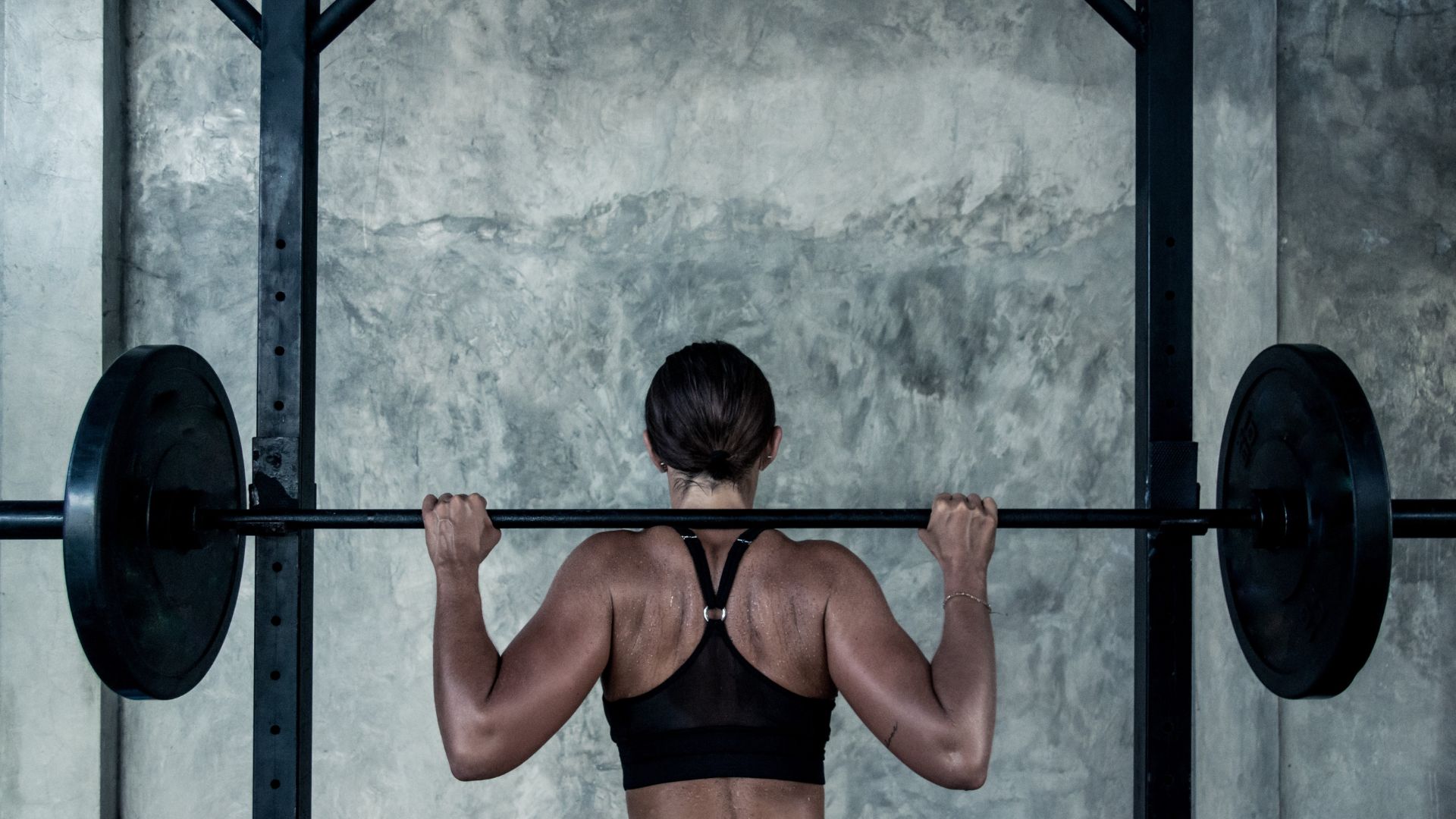Unlocking the secrets to sculpted and strong glutes begins with selecting the right squat variations.
In this blog post, we’ll delve into a variety of squat exercises, each with its unique benefits for targeting and enhancing your glute muscles.
Whether you’re a fitness enthusiast or simply seeking to improve your lower body strength, understanding the nuances of these squat techniques will help you achieve your glute-focused fitness goals. Let’s explore the world of squats and discover which variations are best for building the powerful glutes you desire.
Squat variations the best for glutes and why
To target and activate the glutes effectively during squats, it’s important to choose squat variations that emphasize the posterior chain muscles, including the gluteus maximus. Here are some squat variations that are known to be effective for developing the glutes:
Barbell Back Squats: This classic compound exercise places a significant load on the glutes. Focus on proper form, including depth and keeping your back straight.
Sumo Squats: These involve a wider stance with your toes pointed slightly outward. Sumo squats target the inner thighs and glutes more than traditional squats.
Goblet Squats: Holding a dumbbell or kettlebell close to your chest, goblet squats can help you maintain an upright posture and engage the glutes throughout the movement.
Bulgarian Split Squats: Also known as rear-foot elevated split squats, these single-leg squats force the glutes to work harder for stability and strength.
Box Squats: Box squats involve squatting onto a box or bench, which helps you maintain proper depth and can be beneficial for glute activation.
Pause Squats: These involve a brief pause at the bottom of your squat, which increases time under tension and forces the glutes to work harder during the lift.
Front Squats: While primarily targeting the quadriceps, front squats also engage the glutes, especially when you maintain an upright posture.
Zercher Squats: Holding a barbell in the crook of your elbows, Zercher squats can help engage the upper back and glutes, making it a great variation for overall lower body development.
Squat Jumps: Incorporating plyometric movements like squat jumps can add an explosive element to your training, targeting the fast-twitch muscle fibers in your glutes.
Smith Machine Squats: These can be useful for isolating the glutes, especially when you use a wider stance and emphasize the hip thrust at the top of the movement.
When performing any squat variation for glute development, it’s essential to maintain proper form and gradually increase the weight or intensity over time.
Additionally, combining squats with other glute-specific exercises like lunges, deadlifts, and hip thrusts can help you achieve a well-rounded glute workout routine.
Further Explanations.
Let’s delve deeper, let me explain these variations mentioned further.
First, let’s delve into more detail about the Barbell Back Squats and Sumo Squats and how they work the glutes:
1. Barbell Back Squats.
Muscles Targeted:
Barbell back squats are a fundamental lower body exercise that primarily targets the quadriceps, hamstrings, and gluteus maximus.

The glutes play a significant role in this exercise, particularly during the ascent phase.
Glute Activation:
As you descend into a squat, your hips move backward, which causes your glutes to stretch.
This stretching is known as eccentric contraction. During the ascent, when you push the weight back up, your glutes contract concentrically to extend your hips and return to a standing position.
Form and Depth:
To effectively target the glutes, it’s crucial to perform back squats with proper form.
Keep your back straight, chest up, and knees tracking over your toes. Descend until your thighs are at least parallel to the ground or go deeper (known as “breaking parallel”) for maximum glute activation.
2. Sumo Squats.
Stance:
Sumo squats, also known as wide-stance squats, involve positioning your feet wider apart than shoulder-width with your toes pointing slightly outward, often at a 45-degree angle.
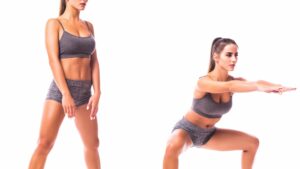
Muscles Targeted:
Sumo squats shift the emphasis compared to traditional squats. While they still work the quadriceps, hamstrings, and lower back, they place more emphasis on the adductors (inner thigh muscles) and the glutes.
Glute Activation:
The wide stance in sumo squats places the hips in a position that demands more work from the gluteus maximus for both stability and movement.
The outward rotation of the toes allows for greater glute engagement during the lift.
Form:
Maintain an upright torso and keep your back straight during sumo squats. Descend by pushing your hips back and bending your knees, ensuring your knees track over your toes.
Sumo squats are an excellent choice if you want to target your inner thighs and glutes more directly compared to traditional squats.
They can also help improve hip mobility and flexibility due to the wider stance. As with any exercise, it’s essential to use proper form and gradually increase the weight as your strength improves to get the best results and avoid injury.
Let’s explore the details of Goblet Squats and Bulgarian Split Squats, including how they work the glutes:
3. Goblet Squats:
Execution:
Goblet squats are performed by holding a dumbbell or kettlebell close to your chest with both hands. You stand with your feet shoulder-width apart.

Muscles Targeted:
Goblet squats are a compound exercise that targets various muscle groups, including the quadriceps, hamstrings, lower back, and, importantly, the gluteus maximus.
Glute Activation:
The goblet squat’s unique feature is the weight placement. Holding the weight close to your chest encourages an upright torso and good posture throughout the movement.
This posture forces the glutes to engage more effectively as you descend and ascend.
Upright Posture:
The upright posture also shifts some of the emphasis from the lower back to the glutes, making them a great choice for those looking to strengthen and tone their glutes while minimizing strain on the lower back.
Goblet squats are an excellent choice for individuals of various fitness levels as they promote proper form, balance, and glute activation.
4. Bulgarian Split Squats (Rear-Foot Elevated Split Squats).
Execution:
Bulgarian split squats are a single-leg exercise. To perform them, you stand a few feet away from a bench or platform, place one foot behind you on the bench, and hold dumbbells or a barbell for added resistance.

Muscles Targeted:
This exercise primarily targets the quadriceps, hamstrings, and gluteus maximus. It also engages the gluteus medius and stabilizer muscles due to the single-leg stance.
Glute Activation:
Bulgarian split squats force the glutes to work harder for stability and strength since they are responsible for stabilizing your body while the front leg does the majority of the lifting.
Stability and Balance:
The elevated rear foot allows for a deeper range of motion, which further engages the glutes during the exercise. The movement’s unilateral nature also helps address any muscle imbalances between the left and right sides.
Bulgarian split squats are an excellent addition to leg workouts, especially for those seeking to improve glute strength, balance, and symmetry.
It’s essential to use proper form, control the movement, and gradually increase the resistance to maximize the benefits and minimize the risk of injury.
let’s explore the benefits and details of Box Squats and Pause Squats in terms of glute activation:
5. Box Squats.
Execution:
Box squats involve squatting onto a box or bench placed behind you. You initiate the squat movement by pushing your hips back and bending your knees until your buttocks lightly touch the box or bench, and then you push back up to the starting position.

Muscles Targeted:
Box squats primarily target the quadriceps, hamstrings, and gluteus maximus. However, they place a unique emphasis on glute activation and posterior chain strength due to the seated position on the box.
Glute Activation:
The box provides a consistent point of reference for squat depth, ensuring that you reach a specific depth with each repetition.
This helps you maintain proper form and ensures that your glutes are fully engaged during each squat.
Depth and Control:
By sitting onto the box, you pause briefly before returning to the standing position, which increases the time under tension on your glutes and hamstrings. This can lead to improved glute development and strength.
Box squats can be particularly useful for individuals looking to enhance their squat form, target the glutes, and build strength without relying on the stretch reflex that occurs in standard squats.
6. Pause Squats:
Execution:
Pause squats are performed like traditional squats, but with one significant difference – you pause at the bottom of the squat position, holding it for a predetermined amount of time (typically 1-3 seconds), before ascending back to the starting position.
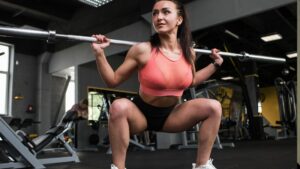
Muscles Targeted:
Pause squats work the same muscle groups as standard squats, including the quadriceps, hamstrings, and gluteus maximus. However, the pause adds an extra challenge to the glutes.
Glute Activation:
The pause at the bottom of the squat eliminates the stretch reflex and requires your glutes to work harder to initiate the upward movement.
This increased time under tension can lead to greater glute activation and development.
Strength and Control:
Pause squats are excellent for building strength and control throughout the entire range of motion, including the most challenging phase at the bottom.
Incorporating pause squats into your training can help you break through plateaus, improve glute strength, and enhance your squatting form by reinforcing proper depth and control.
Just like with any squat variation, maintaining proper form and gradually increasing the weight or pause duration will yield the best results.
let’s delve into the details of Front Squats and Zercher Squats, including how they engage the glutes:
7. Front Squats.
Execution:
In front squats, you hold a barbell across the front of your shoulders with your arms crossed and your elbows pointing forward. The squatting motion is similar to that of a back squat, but with the barbell in front.
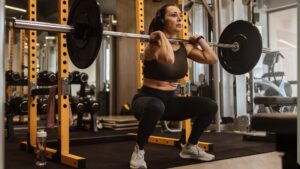
Muscles Targeted:
Front squats primarily target the quadriceps, placing a significant load on them due to the front rack position. However, they also engage the glutes and other lower body muscles.
Glute Activation:
Maintaining an upright posture during front squats is crucial. This posture places a unique demand on the glutes to assist in stabilizing the torso and controlling the weight.
As you descend and ascend in the squat, the glutes are actively engaged to support your trunk and hips.
Upright Posture:
The need for an upright posture distinguishes front squats from back squats and enhances glute engagement.
Front squats are an excellent variation for targeting both the quadriceps and the glutes, especially when you aim to develop strength and stability in the front of your body.
8. Zercher Squats.
Execution:
Zercher squats involve holding a barbell in the crook of your elbows, typically with a mixed grip. You perform the squatting motion with the weight cradled in your arms.

Muscles Targeted:
Zercher squats are a compound lower body exercise that works the quadriceps, hamstrings, lower back, and the glutes.
Glute Engagement:
Zercher squats require strong glute engagement because the weight is held in a position that places additional strain on the upper back and core muscles.
Your glutes help stabilize your spine and control the descent and ascent of the squat.
Upper Body Engagement:
The upper back engagement in Zercher squats contributes to overall lower body development, as the upper back muscles assist in maintaining posture and balance.
Zercher squats offer a unique challenge to the glutes and upper back muscles due to the unconventional barbell placement.
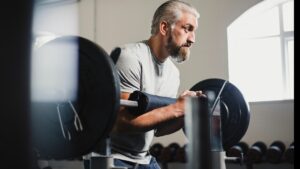
They can be a valuable addition to your lower body workout routine, helping to improve glute strength and overall stability.
As with any squat variation, it’s crucial to maintain proper form and gradually increase the weight to ensure safe and effective training.
Let’s explore the benefits and specifics of Squat Jumps and Smith Machine Squats, including how they affect the glutes:
9. Squat Jumps.
Execution:
Squat jumps are a plyometric exercise that combines a squat with an explosive jump. Begin with a regular bodyweight squat, then explode upward, jumping as high as you can, and land softly before immediately going into the next squat.
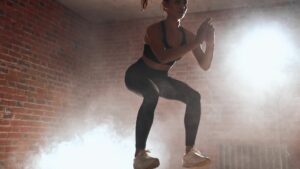
Muscles Targeted:
Squat jumps target various muscle groups, including the quadriceps, hamstrings, calves, and, importantly, the gluteus maximus.
Glute Activation:
The explosive nature of squat jumps engages the fast-twitch muscle fibers in your glutes. These fast-twitch fibers are responsible for powerful and explosive movements, making squat jumps an effective exercise for developing explosive strength in the glutes.
Plyometric Training:
Squat jumps are part of plyometric training, which not only strengthens the muscles but also enhances their ability to generate force quickly, helping you improve athletic performance.
Squat jumps can be a valuable addition to your training routine to develop explosive power in the glutes and lower body.
However, they should be performed with caution, as they can be high-impact. Ensure proper landing technique and consider starting with lower-intensity plyometric exercises if you are new to this type of training.
10. Smith Machine Squats.
Execution:
Smith machine squats are performed using a Smith machine, which consists of a guided barbell. The barbell moves in a fixed vertical path. You stand under the barbell, place it on your shoulders, and perform squats.
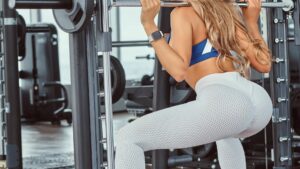
Muscles Targeted:
Smith machine squats primarily target the quadriceps, hamstrings, and gluteus maximus.
Glute Isolation:
While Smith machine squats can engage the glutes, their effectiveness in targeting the glutes depends on your form and stance.
To emphasize the glutes, you can use a wider stance and focus on emphasizing the hip thrust at the top of the movement.
Stabilization:
The Smith machine provides stability, which can be beneficial for isolating specific muscle groups like the glutes without the need for balancing the weight.
Smith machine squats are a suitable option for those who want to isolate and target their glutes more directly while minimizing the need for balance and stabilization.
By adjusting your stance and focusing on hip thrust at the top of the movement, you can enhance glute engagement in this exercise.
As with any exercise, it’s important to use proper form and technique to maximize the benefits and minimize the risk of injury during Smith machine squats and plyometric movements like squat jumps.
A tabular on this including the ratio.
Here’s a tabular comparison of different squat variations based on their effectiveness for targeting the glutes.
| Squat Variation | Glute Engagement | Effectiveness Ratio (Glutes) |
|---|---|---|
| Barbell Back Squats | High | 4/5 |
| Sumo Squats | High | 4/5 |
| Goblet Squats | Moderate | 3/5 |
| Bulgarian Split Squats | High | 4/5 |
| Box Squats | Moderate | 3/5 |
| Pause Squats | Moderate | 3/5 |
| Front Squats | Moderate | 3/5 |
| Zercher Squats | Moderate | 3/5 |
| Squat Jumps | High | 4/5 |
| Smith Machine Squats | Variable | 3/5 |
Please keep in mind that the effectiveness of each squat variation for targeting the glutes can vary depending on factors such as individual biomechanics, form, and training goals.
Additionally, the “effectiveness ratio” is a simplified subjective measure and may not fully represent an individual’s experience. It’s essential to incorporate a variety of squat variations into your training routine to achieve a well-rounded glute development while focusing on proper form and progressively increasing the intensity over time.
Conclusion.
In conclusion, several squat variations effectively engage the glutes, with high engagement seen in exercises like Barbell Back Squats, Sumo Squats, Bulgarian Split Squats, and Squat Jumps. While others, like Goblet Squats, Box Squats, and Front Squats, offer moderate engagement.
Smith Machine Squats’ effectiveness can vary depending on individual factors. Incorporating a mix of these squat variations into your routine, while focusing on proper form, will help develop well-rounded glutes.

Hey there, it’s Mike Rrsq, the Editor-in-Chief over at Jsquat.com, and I’m absolutely obsessed with all things squat fitness! I’ve been lucky enough to get some serious recognition for my work in this field. With a solid background in the fitness and wellness industry, I’ve been there right from the get-go, helping shape this website into what it is today.
You see, I’m not just the boss around here; I’m also a passionate contributor. I love sharing my insights through my articles, and trust me, they’re not your run-of-the-mill stuff. Each piece I write is a labor of love, filled with my expertise and real-world experience in the fitness universe. So, if you’re into fitness and looking for some inspiration, you’re in the right place!

